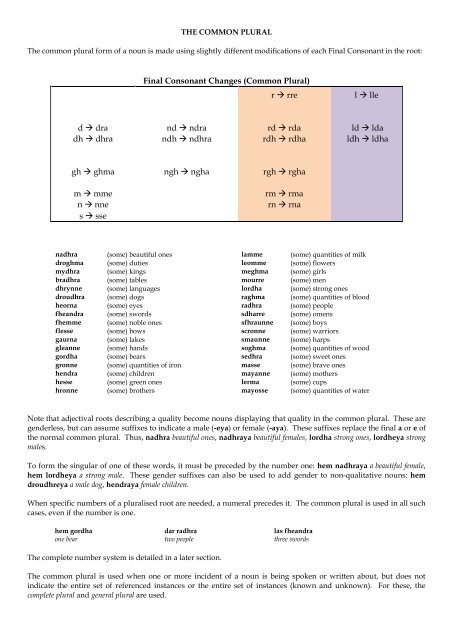Create successful ePaper yourself
Turn your PDF publications into a flip-book with our unique Google optimized e-Paper software.
THE COMMON PLURAL<br />
The common plural form of a noun is made using slightly different modifications of each Final Consonant in the root:<br />
Final Consonant Changes (Common Plural)<br />
r rre<br />
l lle<br />
d dra nd ndra rd rda ld lda<br />
dh dhra ndh ndhra rdh rdha ldh ldha<br />
gh ghma ngh ngha rgh rgha<br />
m mme<br />
n nne<br />
s sse<br />
rm rma<br />
rn rna<br />
nadhra (some) beautiful ones lamme (some) quantities of milk<br />
droghma (some) duties leomme (some) flowers<br />
mydhra (some) kings meghma (some) girls<br />
bradhra (some) tables mourre (some) men<br />
dhrynne (some) languages lordha (some) strong ones<br />
droudhra (some) dogs raghma (some) quantities of blood<br />
heorna (some) eyes radhra (some) people<br />
fheandra (some) swords sdharre (some) omens<br />
fhemme (some) noble ones sfhraunne (some) boys<br />
flesse (some) bows scronne (some) warriors<br />
gaurna (some) lakes smaunne (some) harps<br />
gleanne (some) hands soghma (some) quantities of wood<br />
gordha (some) bears sedhra (some) sweet ones<br />
gronne (some) quantities of iron masse (some) brave ones<br />
hendra (some) children mayanne (some) mothers<br />
hesse (some) green ones lerma (some) cups<br />
hronne (some) brothers mayosse (some) quantities of water<br />
Note that adjectival roots describing a quality become nouns displaying that quality in the common plural. These are<br />
genderless, but can assume suffixes to indicate a male (-eya) or female (-aya). These suffixes replace the final a or e of<br />
the normal common plural. Thus, nadhra beautiful ones, nadhraya beautiful females, lordha strong ones, lordheya strong<br />
males.<br />
To form the singular of one of these words, it must be preceded by the number one: hem nadhraya a beautiful female,<br />
hem lordheya a strong male. These gender suffixes can also be used to add gender to non-qualitative nouns: hem<br />
droudhreya a male dog, hendraya female children.<br />
When specific numbers of a pluralised root are needed, a numeral precedes it. The common plural is used in all such<br />
cases, even if the number is one.<br />
hem gordha dar radhra las fheandra<br />
one bear two people three swords<br />
The complete number system is detailed in a later section.<br />
The common plural is used when one or more incident of a noun is being spoken or written about, but does not<br />
indicate the entire set of referenced instances or the entire set of instances (known and unknown). For these, the<br />
complete plural and general plural are used.


